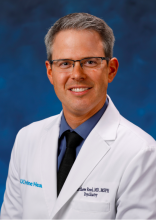SAN DIEGO – Patients with somatic symptom and related disorders can get better in primary care when clinicians use a few key strategies, according to an expert.
When it comes to these disorders, “a lot of our anxiety and gallows humor comes from a place of not knowing what we want to do, how we can treat these individuals,” said Matthew Reed, MD, MPH, a psychiatrist and pain specialist at the University of California, Irvine. “It became more appealing once I learned a little bit more about what was going on with some of these disorders and how I might be able to intervene.”
Dr. Reed spoke at Pain Care for Primary Care, held by the American Pain Society and Global Academy for Medical Education. Global Academy and this news organization are owned by the same company.
Throughout his presentation, Dr. Reed drew upon the listing of somatic symptom and related disorders as outlined in the Diagnostic and Statistical Manual of Mental Disorders, 5th edition (DSM-5). Among the disorders he discussed:
Somatic symptom disorder
This disorder causes significant distress because of at least one somatic symptom and is persistent (lasting over 6 months). A medical illness might be present, and depression and anxiety are common.
“This diagnosis says you have pathology – this somatic disorder – which is making your life miserable,” Dr. Reed said.
He’s often thrilled when patients also have comorbid depression and/or anxiety. “You treat that primary issue, and the somatic disorder melts away,” he said. “It’s harder when you have the pure version of somatic disorder, and there is no anxiety or depressive disorder.”
Illness anxiety disorder (formerly known as hypochondriasis)
Patients with this disorder have been preoccupied about having a serious illness for at least 6 months but do not have somatic symptoms. Reassurance typically is not effective, Dr. Reed said. In response to a statement such as “nothing’s wrong,” he said, patients might reply with a statement along the lines of “something’s wrong because I’m suffering.”
Patients with this condition can command “high rates of medical utilization, often pretty inappropriate,” especially if they are VIPs, he said.
Conversion disorder (also known as functional neurological symptom disorder)
This is less common than the other disorders. Patients with this condition develop “one or more symptoms of altered voluntary motor or sensory function” that’s “not better explained by another medical condition.”
A “listening ear” and physical therapy can prove helpful, Dr. Reed said.
Factitious disorder
Patients with this condition falsify or induce signs of illness, impairment, or injury. “There’s more of an overt feigning of symptoms in order to maintain that sick role,” said Dr. Reed, who cautioned that some people with this condition actually might be suffering.
Protocol can guide treatment
How can these conditions be treated in patients? Dr. Reed pointed to the protocol discussed by Robert McCarron, DO, and embedded in the mnemonic “CARE MD”: Cognitive-behavioral therapy (CBT)/consultation, regular visits, empathy, med-psych interface, and do no harm.

